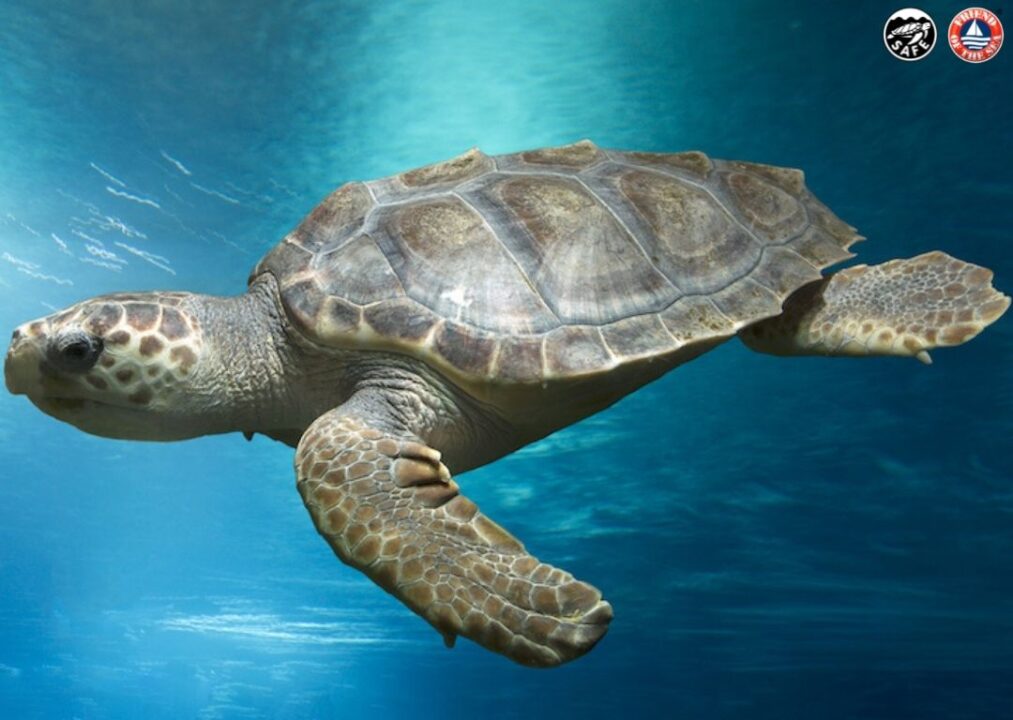World Turtle Day is marked globally on May 23rd, to commemorate the day Friend of the Sea® and the World Sustainability Foundation is giving you insight into one of the world’s most intriguing yet endangered creatures – The Loggerhead Sea Turtle, a species also known as Caretta caretta.
Turtles have been in existence for over 200 million years – making them one of the oldest species on earth. However, many of them face the risk of extinction, primarily resulting from human-related threats.
Friend of the Sea®, a program of the World Sustainability Organization, has developed a set of measures you can implement to protect turtles.
Visit our webpage to learn possible solutions to save the turtles.
Loggerhead Sea Turtle
The Loggerhead Sea Turtle is a member of the Chelonidae family.
This species can grow between 80-140cm in length, with variable mass of an estimated 100 and 160kg. The oceanic turtle species, Loggerhead Sea Turtle has a large head and a curved rostrum (usually referred to as a muzzle).
Its limbs / flippers are highly developed particularly in the front; with two nails for young turtles and one nail for adults. The front flippers have more developed muscles for aquatic movement, while the back flippers act as rudders, directing and stabilizing the swimming act.
This specimen has a shell that can reach up to 110 centimeters in length! The carapace (shell’s upper part) is red-brown, also characterized by 5 pairs of costal scutes.
Here are some amazing facts about sea turtles. Read till the end if you want to unravel five fun facts about Caretta caretta!
Where can Sea Turtles be found?
One of Caretta caretta’s preferred destinations to nest is Italy: in particular, the Ionian coast of southern Calabria.
However, you can also find them around the Mediterranean coasts, in Greece, Turkey, Libya, and Cyprus. The females go to the beaches to lay their eggs, which hatch after an incubation of approximately 50 days. After which the newborns must independently reach the water. With the absence of parental care, they quickly adjust to taking care of themselves.
What does the Loggerhead Sea Turtle Eat?
This turtle species feeds on shellfish, crustaceans, fishes and jellyfishes, it also crushes crab shells or sea urchins with its large and powerful jaws. Surprisingly, the Loggerhead Sea Turtle has absolutely no teeth! However, it has sharp protrusions which serve as an effective tool to shred food.
All you need to know about the Loggerhead Sea Turtles Reproduction
The Loggerhead Sea Turtle reaches sexual maturity at about 25 years; during the breeding season migration from feeding areas to mating areas takes place.
In the process of mating, the male remains attached to the female with the help of its claws on the front legs, however this process can take many hours. It is therefore common that the male is driven out by other members of the same species who will take its place; in fact in a single brood there may be eggs fecundated by different males.
After mating, the females wait a few days in the water, they then head to the beaches where they dig deep holes and lay up to 200 eggs. The eggs are covered with care for a while, and the female Loggerhead Sea Turtles make their way back to the sea.
The eggs hatch simultaneously after an incubation of approximately 42 to 65 days, this is however dependent on the incubation temperature. A higher temperature enables the embryos to develop faster, while lower temperature results in slower development.
The gender of a newborn is dependent on the soil temperature – incubation temperatures close to 32 °C produce only females, while temperatures close to 26 °C produce only males and at 29 °C produces approximately the same number of females and males.
Quickly after hatching, the newborns face a difficult ascent of the sand layer that separates them from the surface. Once they emerge during the night, they are guided by the gradient of light to reach the water, as the sea tends to be brighter than sand dunes.
After birth there is no parental care, so the newborns are made to fend for themselves. Usually, a female Caretta caretta reproduces on alternate years or every 3 years. During the summer, a female can lay 3 or 4 nests at intervals of 12-16 days, and usually tends to nest on the beach where she was born.
Where does the Loggerhead Sea Turtle Breed?
Caretta caretta is the most common turtle of the Mediterranean Sea, but it can also be found in the upper Adriatic and the Ionian Sea. Additionally, the species is spread in the temperate and tropical waters of the Atlantic, Pacific and Indian Oceans.
The most common breeding areas are in Greece, Turkey, Libya and Cyprus, but among the areas preferred by these turtles to nest there is Italy. Specifically the Ionian coast of southern Calabria. Nesting takes place on sandy beaches located in the Pelagie Islands and Southern Sicily.
Status and Major Threats
Caretta caretta is currently classified as vulnerable by the International Union for Conservation of Nature red list endangered species.
It is particularly threatened by human related activities such as bycatch, trapping in fishing nets, bathing tourism at nesting sites, coastal lighting, habitat contamination caused by plastics objects thrown into the sea; which can be swallowed by the turtle, and accumulate in their stomach or cause suffocation.
A major threat not to be underestimated is the impact of global warming, which causes serious imbalances in newborn populations as a result of the changing temperatures, leading to unpredictable sex of newborn Loggerhead Sea Turtles.
Fortunately, today there are many associations that control and protect reproductive sites. A wider information and awareness-raising campaign for fishermen is required to use less invasive fishing nets, as well as to share improved handling methods on board vessels, with the aim of reducing post-catch mortality.
Friend of the Sea, a project of the World Sustainability Organization, an international NGO whose mission is to promote environmental conservation, makes significant contribution by means of the “Turtle Safe” Project. Through the initiative, specific standards are imposed on fishing companies to reduce the catches of these beautiful yet endangered animals and ensure their protection.
You made it to the end, now here are 5 Fun Facts about the Loggerhead Sea Turtle!
– The Loggerhead Sea Turtle has lungs, yet it is able to perform very long apnea that lasts from five to twenty minutes, during this period breathing is temporarily suspended.
– The Loggerhead Sea Turtle is very fast and can reach speeds higher than 35 km/h!
– Did you know that 9 °C is water temperature capable of causing a phenomenon known as “cold stunning’’? Because sea turtles are heterothermic / cold-blooded reptiles, they depend on external sources of heat to determine body temperature.
– The Loggerhead Sea Turtle is the only species of sea turtle to lay eggs in Italy.
– There are 3 ecological stages in a Caretta caretta’s life: Pelagic – meaning offshore life, Demersal – the approach to the seabed, and finally an intermediate Neritic phase – this occurs when a turtle approaches the coast within 200 meters of depth from the open sea.
Now you have discovered all you need to know about the Caretta caretta, support us at Friend of the Sea®, in our quest to protect the special Loggerhead Sea Turtle from extinction.




